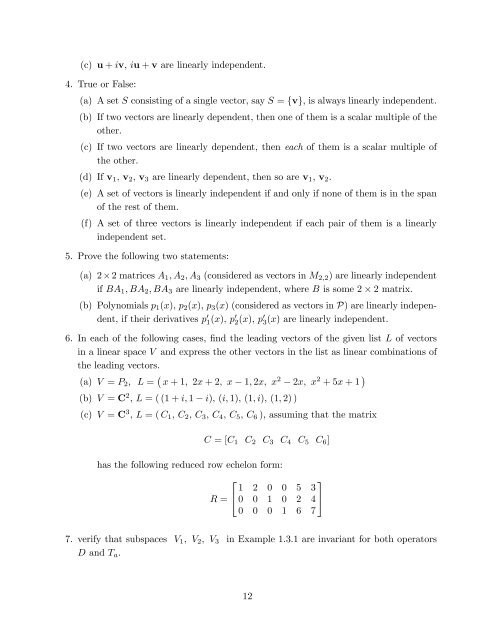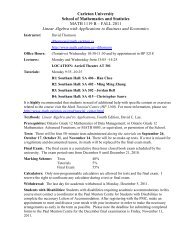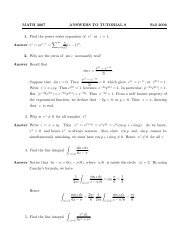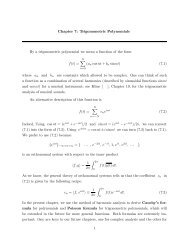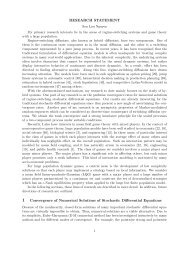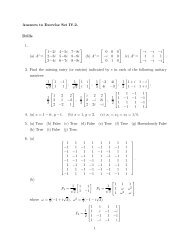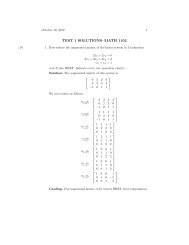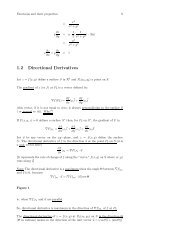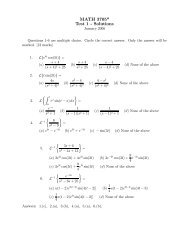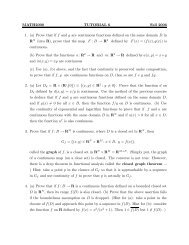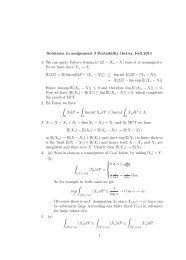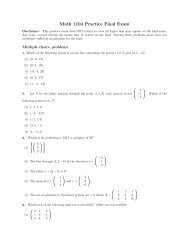CHAPTER II DIMENSION In the present chapter we investigate ...
CHAPTER II DIMENSION In the present chapter we investigate ...
CHAPTER II DIMENSION In the present chapter we investigate ...
You also want an ePaper? Increase the reach of your titles
YUMPU automatically turns print PDFs into web optimized ePapers that Google loves.
(c) u + iv, iu + v are linearly independent.<br />
4. True or False:<br />
(a) A set S consisting of a single vector, say S = {v}, is always linearly independent.<br />
(b) If two vectors are linearly dependent, <strong>the</strong>n one of <strong>the</strong>m is a scalar multiple of <strong>the</strong><br />
o<strong>the</strong>r.<br />
(c) If two vectors are linearly dependent, <strong>the</strong>n each of <strong>the</strong>m is a scalar multiple of<br />
<strong>the</strong> o<strong>the</strong>r.<br />
(d) If v1, v2, v3 are linearly dependent, <strong>the</strong>n so are v1, v2.<br />
(e) A set of vectors is linearly independent if and only if none of <strong>the</strong>m is in <strong>the</strong> span<br />
of <strong>the</strong> rest of <strong>the</strong>m.<br />
(f) A set of three vectors is linearly independent if each pair of <strong>the</strong>m is a linearly<br />
independent set.<br />
5. Prove <strong>the</strong> following two statements:<br />
(a) 2×2 matrices A1, A2, A3 (considered as vectors in M2,2) are linearly independent<br />
if BA1, BA2, BA3 are linearly independent, where B is some 2 × 2 matrix.<br />
(b) Polynomials p1(x), p2(x), p3(x) (considered as vectors in P) are linearly independent,<br />
if <strong>the</strong>ir derivatives p ′ 1 (x), p′ 2 (x), p′ 3 (x) are linearly independent.<br />
6. <strong>In</strong> each of <strong>the</strong> following cases, find <strong>the</strong> leading vectors of <strong>the</strong> given list L of vectors<br />
in a linear space V and express <strong>the</strong> o<strong>the</strong>r vectors in <strong>the</strong> list as linear combinations of<br />
<strong>the</strong> leading vectors.<br />
(a) V = P2, L = x + 1, 2x + 2, x − 1, 2x, x 2 − 2x, x 2 + 5x + 1 <br />
(b) V = C 2 , L = ( (1 + i, 1 − i), (i, 1), (1, i), (1, 2) )<br />
(c) V = C 3 , L = ( C1, C2, C3, C4, C5, C6 ), assuming that <strong>the</strong> matrix<br />
C = [C1 C2 C3 C4 C5 C6]<br />
has <strong>the</strong> following reduced row echelon form:<br />
⎡<br />
1<br />
R = ⎣ 0<br />
2<br />
0<br />
0<br />
1<br />
0<br />
0<br />
5<br />
2<br />
⎤<br />
3<br />
4 ⎦<br />
0 0 0 1 6 7<br />
7. verify that subspaces V1, V2, V3 in Example 1.3.1 are invariant for both operators<br />
D and Ta.<br />
12


